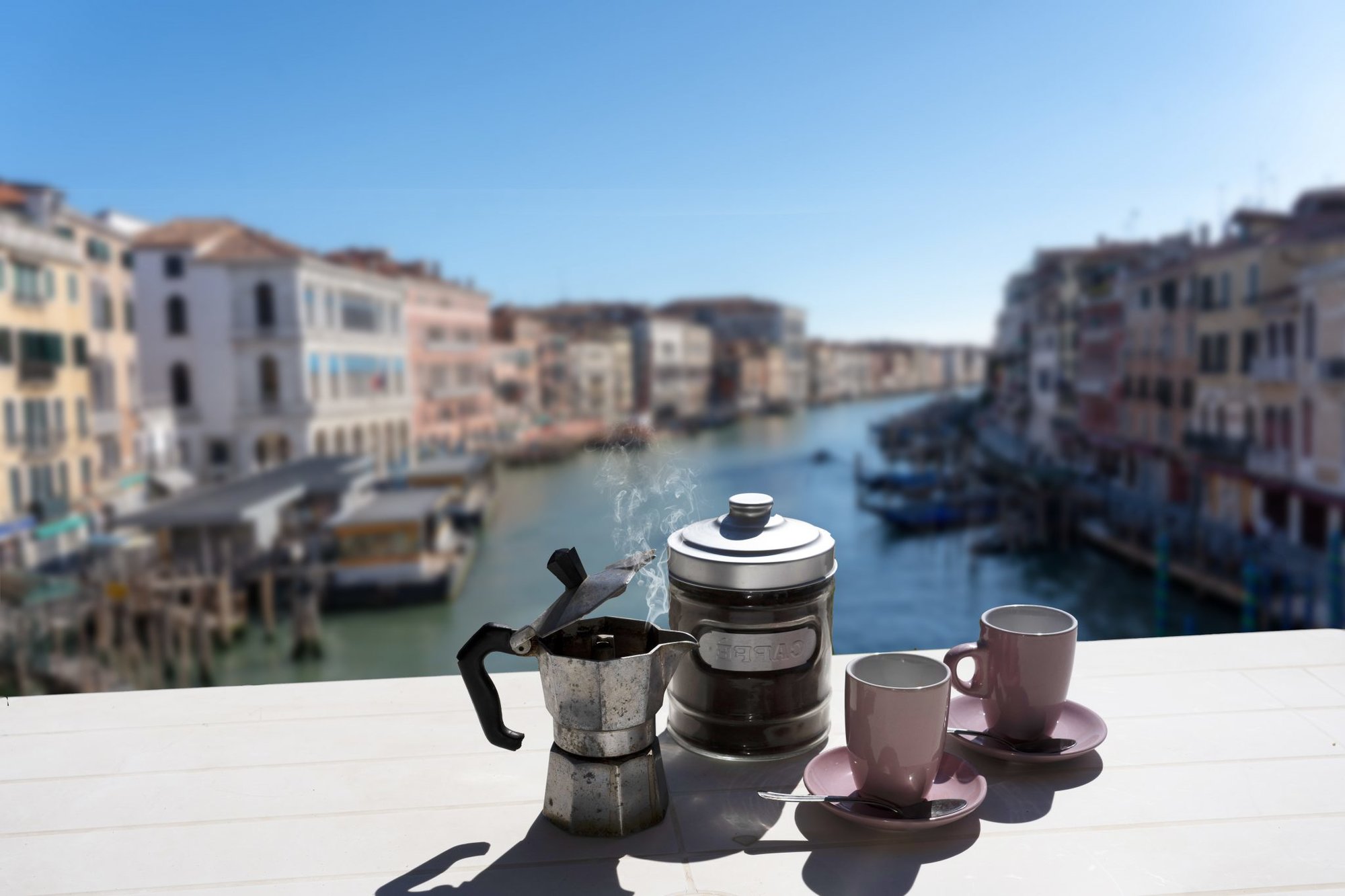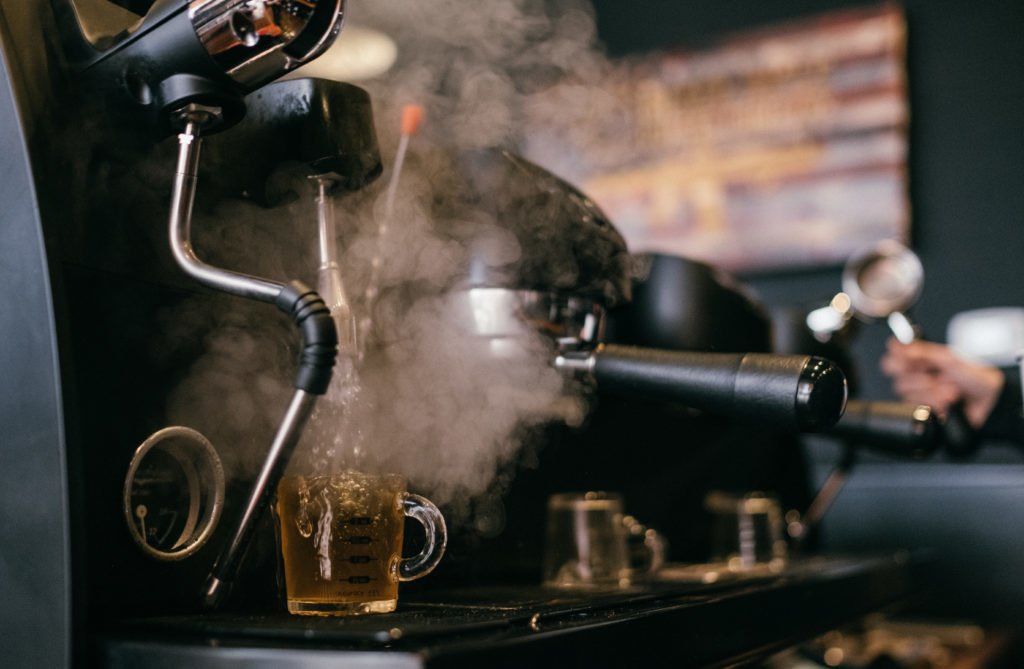
coffee for two from the rialto bridge – view of venice canal grand. Adobe Stock photo.
From its gorgeous and uniquely framed architectural landscapes to Vespas, pasta, and world-class wine, Italy is known for its beauty, luxury, and celebrations of all the finer things in life. Coffee has an esteemed reputation in the country as well — Italians across the Bel Paese wouldn’t dream of going through their day, or perhaps even settling in for the night, without the help of an espresso. Coffee has become as important to Italian culture as pizza and gelato.
Just as there are a variety of wines to choose from, each with its own particular body and taste, coffee is no different. In Italy, caffè means coffee and is also the common way to order a drink from a local coffeehouse. It’s routine for most to begin their morning with a cappuccino or caffè latte before shifting to a standard espresso later in the day.

Although there are many theories as to when and where coffee originated, it’s believed the famous beverage made its way to Europe once it began distribution from Ethiopia and Yemen. In fact, Venice, an island city off the northeast coast of Italy, was reportedly one of the first European ports to import beans in the 19th century. Although the commodity was first consumed only by the wealthy, coffee eventually grew in popularity.
In 1884, Angelo Moriondo took a bronze medal at the General Exposition in Turin for his steam-based bulk coffee machine. By 1901, Milanese manufacturer Luigi Bezzera invented the single-shot espresso, putting Italy at the top of the board as a global leader in the coffee industry.
The espresso machine was a revolutionary concept for the Italian people. Prior to Bezzera’s invention, coffee was traditionally made by pulverizing ground beans into boiling water, a time-consuming practice. Bezzera’s first espresso machine, made of metal that sat on top of an open flame, was filled halfway with water. As the water’s temperature rose, steam would build, allowing baristas to place ground coffee at the bottom of the machine, resulting in a hot batch of espresso, made in just under a minute.
Although Bezzera single-handedly created what would become a staple in modern-day society, patents for improvements began flourishing through the 1920s and ’30s, with eager minds setting out to perfect the making, and consuming, of espresso. Perhaps the most famous addition to the espresso machine line was from Giovanni Achille Gaggia in 1938. His innovative creation brewed hot espresso in just 15 seconds. However, by the time World War II began, coffee drinking greatly declined due to fascist dictator Benito Mussolini’s efforts to close Italy’s borders to outside distribution of goods, hindering the country’s beloved potation.

Although Italians were still making their own, much to the disdain of American soldiers who found the drink to be too strong, coffee was mostly replaced with chicory and hibiscus tea, a trend that would quickly change with the approach of the 1950s, when coffee trading soared once again and homes were filled with Moka pots, a style icon created by the talented engineer Alfonso Bialetti. Moka pots, which are still commonly used today, utilize the heat directly from a stovetop to brew a delicious batch of coffee. Its seamless use has made it a kitchen essential for many families, with Mokas widely popular today in Latin America and parts of Europe.
One thing travelers will not see much of in Italy: Starbucks. Although the coffee conglomerate has been in business since the 1970s, it was only three years ago that Italy saw its first Starbucks Reserve Roastery, set in the populous city of Milan. Plans to open Rome’s first Starbucks location were projected for September 2020 but due to the global pandemic were tabled until further notice. Shockingly, Italians are not dismayed.
In Italian culture, coffee is more than just a pick-me-up. Most travelers would be surprised to see that the “to-go” lifestyle is fairly uncommon in Italian society — they believe coffee is meant to be enjoyed. So when in Italy, do as the Italians do — goditi un buon caffè.

BRCC and Bad Moon Print Press team up for an exclusive, limited-edition T-shirt design!
BRCC partners with Team Room Design for an exclusive T-shirt release!
Thirty Seconds Out has partnered with BRCC for an exclusive shirt design invoking the God of Winter.
Lucas O'Hara of Grizzly Forge has teamed up with BRCC for a badass, exclusive Shirt Club T-shirt design featuring his most popular knife and tiomahawk.
Coffee or Die sits down with one of the graphic designers behind Black Rifle Coffee's signature look and vibe.
Biden will award the Medal of Honor to a Vietnam War Army helicopter pilot who risked his life to save a reconnaissance team from almost certain death.
Ever wonder how much Jack Mandaville would f*ck sh*t up if he went back in time? The American Revolution didn't even see him coming.
A nearly 200-year-old West Point time capsule that at first appeared to yield little more than dust contains hidden treasure, the US Military Academy said.












